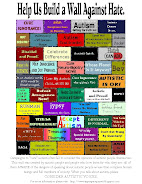What we’d like you to know about Autism
Autism is a
neurological difference classified as a developmental disability.
Autistic people have atypical behaviours in three areas: social
interaction, communication, and restricted interests or repetitive
behaviours. Autistics are different at the most basic level available:
how they experience the world, and how they learn from it. Autism
presents with measurable differences in perception, attention, memory,
intelligence, etc. The autistic order and progress of development is
different from the typical version as is autistic brain structure,
allocation, and function. Autism presents strengths not available to the
typical population, but the different pattern of strengths and
weaknesses characterizing autism results in many difficulties as
atypical needs and adaptive but atypical autistic behaviours are at odds
with what is considered or expected as "normal".
Autism isn't a disease, or a bunch of behaviours, any more than femaleness is. Autism involves neurological differences, which are basic and comprehensive. Autistic neurology is no more or less valid than non-autistic neurology: both autistics and non-autistics are able to develop, learn, progress, and achieve things, but may do so in different ways and may require different kinds of help along the way.
Progress is part of the natural course of development in autistics, as it is in non-autistics, but development in autism may not proceed in the same order as is considered normal for non-autistics. Autistics may, e.g., seem advanced in some areas and delayed in others. Seen in perspective, this means that in comparison with autistics, non-autistics are likely to be advanced in some areas and delayed in others. Non-autistics may need a great deal of assistance in learning things that autistics learn easily, and the reverse may also be true. Seeing as we don't declare non-autistics to be "succeeding in treatment" or "less severely non-autistic" or "recovered" when they develop and learn, it should be clear that describing autistics in these kinds of terms is misleading and prejudicial.
Autistics are alert and aware of what is happening around us, even though we may not be able to show this or respond in expected, typical ways. Autistics also may not communicate in typical ways, and in some situations, will find it difficult to communicate at all. However, this does not reflect a fundamental inability or unwillingness to communicate. Autistics want to communicate, and can do so when provided with a context in which communication is both possible and responded to. This is also true of non-autistics, but non-autistics are much more likely to be provided with contexts in which they can communicate successfully.
Dividing autism into "severe" and "mild", or in similar ways, is misleading and harmful. Autistics may differ in the extent to which autistic traits are or are not obvious, and this may vary in individual autistics from hour to hour, day to day, and year to year, depending on many factors, including on what kind of context an autistic lives in. The extent to which autistic traits are or are not evident in any individual autistic is unrelated to our intelligence and our outcomes as adults. However, societal prejudices against autistic traits may prevent autistics whose traits are more obvious from being considered able to learn, to communicate, to make decisions about our lives, to walk around freely, to be employed, etc.
Autism isn't a disease, or a bunch of behaviours, any more than femaleness is. Autism involves neurological differences, which are basic and comprehensive. Autistic neurology is no more or less valid than non-autistic neurology: both autistics and non-autistics are able to develop, learn, progress, and achieve things, but may do so in different ways and may require different kinds of help along the way.
Progress is part of the natural course of development in autistics, as it is in non-autistics, but development in autism may not proceed in the same order as is considered normal for non-autistics. Autistics may, e.g., seem advanced in some areas and delayed in others. Seen in perspective, this means that in comparison with autistics, non-autistics are likely to be advanced in some areas and delayed in others. Non-autistics may need a great deal of assistance in learning things that autistics learn easily, and the reverse may also be true. Seeing as we don't declare non-autistics to be "succeeding in treatment" or "less severely non-autistic" or "recovered" when they develop and learn, it should be clear that describing autistics in these kinds of terms is misleading and prejudicial.
Autistics are alert and aware of what is happening around us, even though we may not be able to show this or respond in expected, typical ways. Autistics also may not communicate in typical ways, and in some situations, will find it difficult to communicate at all. However, this does not reflect a fundamental inability or unwillingness to communicate. Autistics want to communicate, and can do so when provided with a context in which communication is both possible and responded to. This is also true of non-autistics, but non-autistics are much more likely to be provided with contexts in which they can communicate successfully.
Dividing autism into "severe" and "mild", or in similar ways, is misleading and harmful. Autistics may differ in the extent to which autistic traits are or are not obvious, and this may vary in individual autistics from hour to hour, day to day, and year to year, depending on many factors, including on what kind of context an autistic lives in. The extent to which autistic traits are or are not evident in any individual autistic is unrelated to our intelligence and our outcomes as adults. However, societal prejudices against autistic traits may prevent autistics whose traits are more obvious from being considered able to learn, to communicate, to make decisions about our lives, to walk around freely, to be employed, etc.
Michelle Dawson
Pervasive Developmental Disorders Specialized Clinic
Rivière des Prairies Hospital
University of Montréal
Pervasive Developmental Disorders Specialized Clinic
Rivière des Prairies Hospital
University of Montréal



























